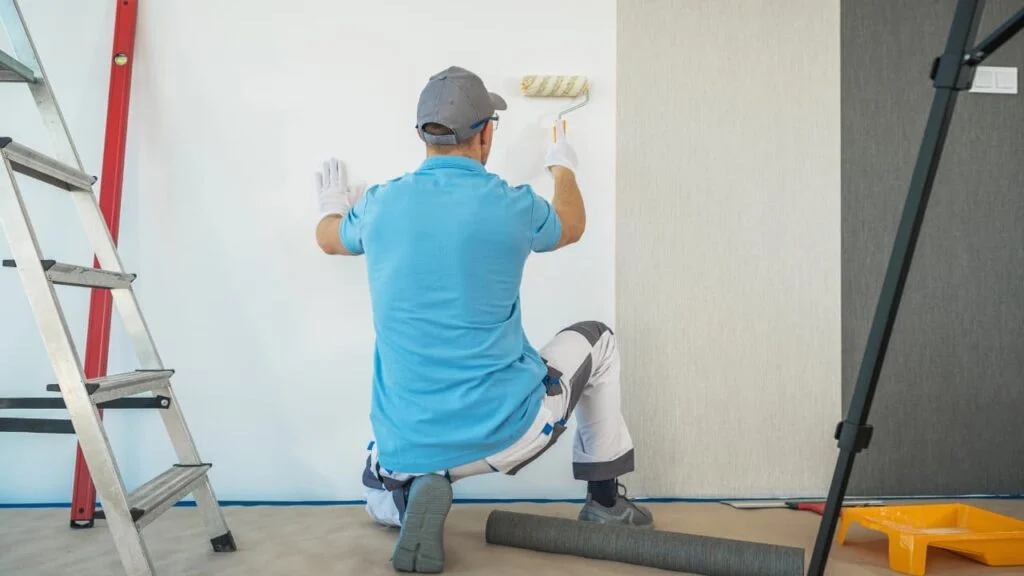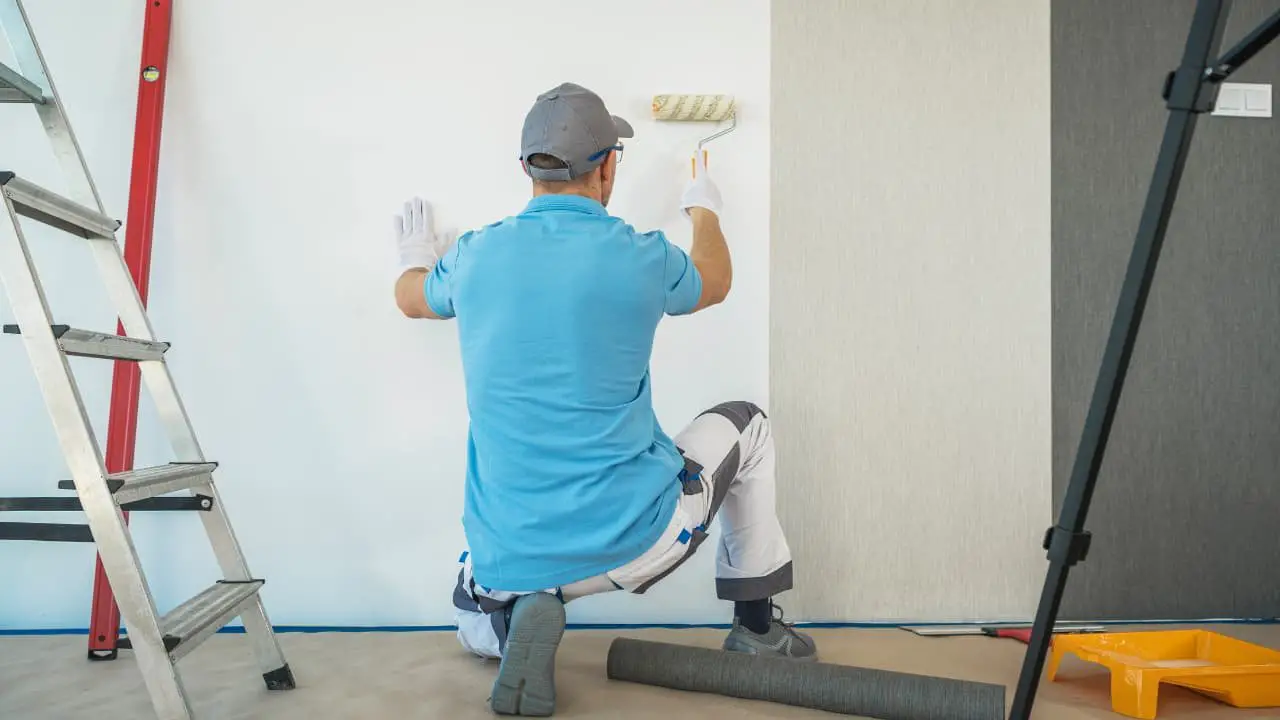Introduction
Are you wondering whether transforming your room’s look by painting over vinyl wallpaper is possible? Contrary to popular belief, it’s a viable option that can save both time and money.
This comprehensive guide will give you insights on the entire process—from tools required, to priming and painting techniques—to successfully applying paint to your walls without peeling off the existing wallpaper.
Ready to uncover this game-changing solution for a dramatic decor transformation? Let’s dive in!
Key Takeaways – Can You Paint Over Vinyl Wallpaper
- Painting over vinyl wallpaper is possible and can save time and money.
- Proper wall preparation, including repairing imperfections and ensuring good adhesion, is crucial for a successful paint job.
- Using high-quality products like Zinsser’s Wallpaper Cover-Up, Bulls Eye 1-2-3 primer, and Perma-White Interior paint will yield better results.
- Consider future redecorating plans when deciding to paint over vinyl wallpaper.
Table of Contents

Understanding Vinyl Wallpaper
Vinyl wallpaper is a popular choice among interior decorators, landlords, and letting agents. This type of wallpaper boasts impressive durability that stems from its primary material – vinyl.
Its sturdy construction makes it highly resistant to moisture and it can easily be cleaned with soap and hot water only, making it an ideal fit for kitchens, bathrooms, or even commercial spaces.
Another significant advantage of vinyl wallpaper is its vast array of design options. From plain hues to intricate patterns, over 4,000 color varieties are available on the market today that cater to every style preference.
The various textured wallpaper surfaces create interesting wall features adding depth and character to any room. However, despite these attractive qualities, there are practical considerations when changing decor schemes involving this kind of wall coverings – particularly when you consider painting over old worn vinyl wallpapers rather than stripping them off entirely.
Can You Paint Over Vinyl Wallpaper?
Yes, it is possible to paint over vinyl wallpaper.
Considerations before painting over wallpaper
Starting the process of painting vinyl wallpaper involves several key considerations. First off, the condition of the wallpaper is paramount; it should be well-adhered to the wall without any peeling edges, air bubbles, or loose bits or seams. If your wallpaper is old and worn, it may be best to consult a professional painter before proceeding.
The condition of the wallpaper
Scrutinizing the condition of your vinyl wallpaper is a critical preliminary step before commencing the first layer of any painting project. Minor irregularities such as air bubbles, torn parts, or rough patches on worn-out wallpapers can detrimentally influence the final paint result.
Thus, employing wall maintenance methods like wall spackle for mending tears and smoothening surfaces proves indispensable. Equally important is ensuring that your surface is clean, dry, and free from anything that might lower adhesion levels.
For example, the removal of organic growth with trisodium phosphate solution aids in achieving a clean wall surface ready for priming and decoration. Ultimately, understanding your wallpaper conditions prior to painting greatly contributes to attaining impeccably painted vinyl wallpapers.
Future redecorating plans
If you have future redecorating plans in mind, it’s important to consider whether painting over vinyl wallpaper is the right choice. One significant benefit of painting over vinyl wallpaper is that when it comes time for a change, the process of removing paint from the walls is much easier compared to stripping traditional wallpaper.
This means that you can easily update your space with a fresh, first coat, of paint without spending hours or even days removing old wallpaper and preparing the walls for light-colored paint. Additionally, by using high-quality products like Zinsser’s Wallpaper Cover-Up and Perma-White Interior, you can ensure long-lasting results that will withstand future redecorating projects.
So if you’re thinking about giving your space a new look down the line, painting over old vinyl wallpaper could be a smart choice that saves you time and effort in the future while still allowing for creativity and personalization.
Necessary Tools for Painting Over Wallpaper
To ensure a successful painting project over vinyl wallpaper, you will need the following tools:
- Zinsser Wallpaper Cover-Up: This high-adhesion product is specifically designed for painting over wallpaper and helps to create a smooth surface for painting.
- Zinsser Bulls Eye 1-2-3: This primer is essential for promoting better paint adhesion and preventing the wallpaper pattern from bleeding through the new paint.
- Zinsser Perma-White Interior: This mold-resistant paint is perfect for vinyl wallpaper as it provides a durable, long-lasting finish and helps to prevent future mold growth.
- Paint brushes and rollers: These are necessary for applying primer and paint to the walls. Choose brushes with synthetic bristles that are compatible with water-based paints.
- Drop cloths or plastic sheets: These will protect floors and furniture from any drips or spills during the painting process.
- Sandpaper or sanding block: Use fine-grit sandpaper to lightly sand the wallpaper surface before priming. This will help create a smoother finish.
- TSP (Trisodium Phosphate) cleaner: This powerful cleaner helps remove any grease, dirt, or adhesive residue from the wallpaper before painting. Dilute according to the manufacturer’s instructions before use.
The Process of Painting Over Vinyl Wallpaper
Preparing the room involves clearing out furniture, covering floors, and remaining surfaces to protect them from paint drips or spills.
Preparing the room
To ensure a successful outcome when painting over vinyl wallpaper, proper preparation of the room is essential. Start with surface preparation by clearing out all furniture and belongings from the space to provide easy access to the walls.
Remove any loose or hanging objects that could get in the way while working on floor above. Next, cover the flooring with drop cloths or plastic sheets to protect it from paint drips and spills. Use painter’s tape to mask off any trim, windowsills, or other areas that you want to keep free from paint.
Finally, make sure there is adequate ventilation in the room by opening windows or using fans if necessary.
Preparing the walls
Before painting over vinyl wallpaper, it is crucial to properly prepare the walls. Start by vacuuming or dusting the wallpaper to remove any loose dirt, dust, and debris. Next, inspect the walls for any areas visible signs of damage, such as tears or air bubbles.
Repair these imperfections with a wall spackle and smooth them out using sandpaper if needed.
Additionally, ensure that the wallpaper is firmly adhered to the wall before proceeding with painting. If there are any areas to remove the wallpaper or where the wallpaper is peeling or lifting, use a strong adhesive to secure it back in place.
This will help ensure a smooth and even surface for your paint application.
Priming your walls
Before painting over vinyl wallpaper, it is crucial to properly prime your walls. Priming helps create a smooth surface for the paint and ensures better adhesion. When priming your walls, it is recommended to use Zinsser Bulls Eye 1-2-3 or Perma-White Interior for the best results.
These high-quality primers are designed specifically for painting over vinyl wallpaper and provide excellent coverage and adhesion. By using a suitable primer, you can ensure that the paint will adhere well to the wallpaper, resulting in a long-lasting and professional finish.
Properly primed walls also help prevent peeling or cracking of the paint in the future. So, make sure to invest some time in priming your walls before proceeding with painting over vinyl wallpaper for optimal results.
Painting the walls
After properly preparing and priming your walls, it’s time to start painting over the vinyl wallpaper. Begin by choosing a high-quality paint that is suitable for your project, such as Zinsser Perma-White Interior in the desired finish (matt, satin, or semi-gloss).
This paint not only provides excellent coverage but also offers long-lasting protection against mold and mildew.
Using a brush or roller, apply two full coats of the selected paint evenly across the walls. Take care to cover all areas thoroughly, including any seams between wallpaper and plaster sections.
Highlighting these seams will ensure a seamless appearance once the job is complete.
As you paint, keep an eye out for any air bubbles or rough patches on the wall surface. If you notice any imperfections, use a putty knife or similar tool to smooth them out before they dry.
This will help create a smooth and professional-looking finish.
How to Remove Painted Wallpaper?
Removing painted wallpaper can be a challenging and time consuming task, but with the right approach and tools, it can be done effectively. Here are the steps to remove painted wallpaper:
- Start by scoring the surface of the wallpaper with a scoring tool. This will help loosen the paint and create small holes for water or wallpaper removal solution to penetrate.
- Mix warm water and a wallpaper removal solution according to the manufacturer’s instructions. Apply this mixture to the painted wallpaper using a sponge or spray bottle, ensuring that it is evenly distributed.
- Allow the solution to penetrate the wallpaper for several minutes. This will soften the adhesive underneath.
- Use a putty knife or scraper to gently lift and peel off sections of the painted wallpaper. Start from one corner and work your way across, being careful not to damage the underlying wall.
- If there are stubborn areas where the paint does not easily come off, reapply the water and removal solution mixture and let it sit for a few more minutes before attempting to remove it again.
- After removing all of the painted wallpaper, use warm soapy water and a sponge to clean any residue left on the walls. Rinse thoroughly with clean water afterward.
- Protect yourself by wearing gloves and safety goggles when working with chemicals or scraping tools.
- Test a small inconspicuous area before applying any solutions or using scraping tools, as different wallpapers may react differently.
- Take breaks if needed, as removing painted wallpaper can be physically demanding.
- Ensure proper ventilation in the room while working with chemicals.
- Dispose of any waste materials according to local regulations.
Conclusion
In conclusion, painting over vinyl wallpaper can be a cost-effective and time-saving solution for businesses and landlords. With the right tools, such as Zinsser’s high-adhesion products, it is possible to remove wallpaper and achieve a professional finish.
By following the proper process of preparation, priming, and decorating, properties can be transformed quickly without causing disruptions. So if you’re looking to refresh your space or attract new tenants, consider painting over vinyl wallpaper as a convenient option that delivers great results.
FAQs
1. Can you paint over vinyl wallpaper?
Yes, you can paint over vinyl wallpaper. However, it is important to properly prepare the surface before painting to ensure a successful and long-lasting result.
2. What steps should I take before painting over vinyl wallpaper?
Before painting over vinyl wallpaper, you should clean the surface with a mild detergent solution to remove any dirt or grease. Next, lightly sand the wallpaper to create a rougher texture for better adhesion. Finally, apply a primer specifically designed for use on vinyl surfaces.
3. Do I need to remove the existing wallpaper before painting?
In most cases, it is not necessary to remove the existing vinyl wallpaper before painting. As long as the paper is in good condition with no peeling or bubbling areas, you can proceed with preparing and priming the surface for paint.
4. Will painted vinyl wallpaper be easy to maintain and clean?
Painted vinyl wallpaper can be relatively easy to maintain and clean if done correctly. Use water-based paints that are recommended for use on vinyl surfaces as they provide better durability and washability compared to oil-based paints. Regularly dusting or gently wiping down the walls using a soft cloth or sponge will help keep them looking fresh and clean.

